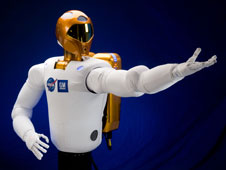Robotic Worker Bound for Space Station Soon
Robonaut 2, a joint project of the space agency and GM, is a 300-pound humanoid robot that can use the same tools astronauts wield. Undergoing testing now, it will be carried to the International Space Station in September by shuttle Discovery.
A human-like robotic assistant -- we've encountered them in science fiction movies and novels for years -- will be toiling on the International Space Station later this year, NASA announced Wednesday. The agency said "the first human-like robot" going into space will become a permanent resident of the station after shuttle Discovery delivers it in a mission scheduled for September.
 Robonaut 2, or R2, was developed jointly by NASA and General Motors under a cooperative agreement to develop a robotic assistant that can work safely alongside people in space and in GM's factories on Earth. 300-pound R2 has a head, torso, arms, and hands. R2 will launch on space shuttle Discovery as part of the STS-133 mission planned for September. It will be confined to operations in the station's Destiny laboratory but might be modified in the future to move more freely around the station's interior or even outside,
Robonaut 2, or R2, was developed jointly by NASA and General Motors under a cooperative agreement to develop a robotic assistant that can work safely alongside people in space and in GM's factories on Earth. 300-pound R2 has a head, torso, arms, and hands. R2 will launch on space shuttle Discovery as part of the STS-133 mission planned for September. It will be confined to operations in the station's Destiny laboratory but might be modified in the future to move more freely around the station's interior or even outside,
"This project exemplifies the promise that a future generation of robots can have both in space and on Earth, not as replacements for humans but as companions that can carry out key supporting roles," said John Olson, director of NASA's Exploration Systems Integration Office in Washington, D.C. "The combined potential of humans and robots is a perfect example of the sum equaling more than the parts. It will allow us to go farther and achieve more than we can probably even imagine today."
R2 is undergoing extensive testing now, including vibration, vacuum, and radiation testing. "The extreme levels of testing R2 has undergone as it prepares to venture to the International Space Station are on par with the validation our vehicles and components go through on the path to production," said Alan Taub, vice president of GM's global research and development. "The work done by GM and NASA engineers also will help us validate manufacturing technologies that will improve the health and safety of our GM team members at our manufacturing plants throughout the world. Partnerships between organizations such as GM and NASA help ensure space exploration, road travel, and manufacturing can become even safer in the future."